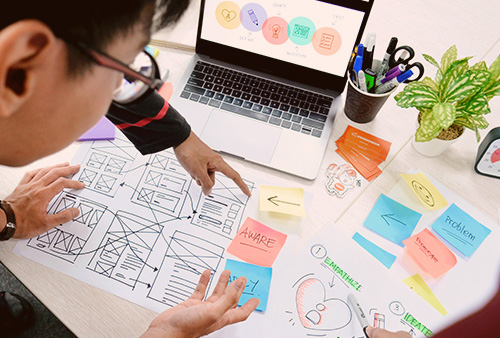
Jump To Section
- 1 What are the Stages of the Product Development Cycle?
- 2 What is Customer-Focused Product Development?
- 3 What Factors are Important in Customer-focused Product Development?
- 4 Designing for the Right Reasons with Customer Research
- 5 How Many Types of Consumer Research Are There?
- 6 Takeaway: Building Better Products with the Right Customer Research
Across any industry in today’s digital age, what is the single most important differentiator that sets apart market leaders from other businesses?
Many will answer that with “customer experience”. And they would be right.
Experience has always been the key differentiator in identifying the right market leader in any industry. An enhanced customer experience has a proven potential of a 200% increase in conversion rate for the business. Concurrently, 89% of customers switch to a rival business as a result of a poor experience with a brand.
But how do enterprises account for the customer experience in the product development cycle?
Before we dive into that, it’s important to know what stages constitute the entire Product Development Cycle.
What are the Stages of the Product Development Cycle?
From ideation to commercialization, the product development cycle goes through multiple stages as the product matures. Broadly, the product development cycle constitutes 5 major stages:
- Ideation
- Research
- Planning
- Prototyping
- Release
In this article, we aim to understand how a customer-focused product development approach can be integrated at each stage of the cycle, what customer data analytics need to be tracked, and what research techniques can be adopted to gather these customer insights.
What is Customer-Focused Product Development?
In the product life cycle, there’s a common perception that as soon as a product is launched, the product development cycle is concluded.
But the lifecycle of product development doesn’t culminate with the release.
Instead, there’s a lot of work that needs to be conducted in the way of customer journey research to ensure that a customer-focused strategy is truly implemented in the process.
What Factors are Important in Customer-focused Product Development?
“Research is creating new knowledge.” – Neil Armstrong
Customer wants and needs are prone to constantly changing as the market gains maturity.
A great product is one that continues to evolve as it matures with the customer at the center.
To implement a customer-focused product development approach, the co-existence of product delivery and customer research is vital — something that should be leveraged not just during but also after the shipment of the product or feature.
Designing for the Right Reasons with Customer Research
During a flight, before the plane takes off, an airline assistant always demonstrates the security protocols, even though every passenger receives a separate leaflet with the same details.
This is a classic example of how observing an aware frequent flyer using the safety jacket reveals undocumented context.
The same concept applies in product development that uses customer journey research to follow a truly customer-focused strategy.
How Many Types of Consumer Research Are There?
There are four different types of research that can be leveraged in the product development cycle.

Each type of customer research comes with its own set of distinct benefits at specific stages of the cycle:

1. Exploratory research
With varying customer needs that evolve with each passing day, oftentimes product teams can end up with unique problems — as well as the demand to understand the problem first to decide on the best approach with which to move forward.
Such situations require a very quick response and a clear segregation of what is known and what still needs to be learned.
Why do it:
Exploratory customer research helps product teams be aware and mindful of the challenges that a particular industry faces.
Learning from both successful and failed launches can be identified early via exploratory research, which helps build empathy with clients and customers alike. With empathy at the core, a product can be designed well for an organization as well as customers.
When to do it:
Exploratory customer research is done at the very beginning, before the product life cycle is kicked off. This can be when there’s a
- New domain (a new market/customer group sharing a common problem or need that needs to be addressed)
- New client (with unique business objectives along with new ideas to mature)
- Pre-sales initiative (by reaching out to an existing client base with ideas to implement with respect to emerging customer needs or technological advancements)
Exploratory research may kick off the following activities:
- Industry benchmarking
- Competitive analysis
- Portfolio overview (Internal Competitive analysis)
- Evaluate across a 2×2 diagram to define maturity and usefulness
- Stakeholder interviews
2. Generative research
An important contributor in the product life cycle, generative customer research paves the way for new ideas, new understandings, and new directions.
For teams focusing on a single problem, particularly while designing UX, generative research helps explore many possible solutions and approaches. This mindset can lead product teams into many different directions, as it should. That being said, it is essential to have defined KPIs for success where each activity is tracked for its progress with clear success metrics.
Why do it:
Generative customer research helps strengthen relationships with clients by engaging in their core business problems.
Two prime benefits include defining the success of the product and relationship building activities, as well as collaborating in upfront research.
When to do it:
- Post major release
- Following a workshop
It may kick off the following activities:
- Design sprint
- Suitable when there is flexibility in budget, scope, and timeline
- Often involves process changes outside the software
- Facilitated workshops
- Focussed collaborations involving the entire team
- Frequency should be once a month to collaborate on product direction and function
- Contextual inquiry
- Context is critical
- Requires a seasoned practitioner
- Ideally should be an environment where the product is going to be used/ or being used
- Output should be a well-defined service blueprint
- Card sorting
- Helps in discovering how people categorize information
3. Formative research
Formative research brings a bigger perspective to the table by analyzing both the qualitative and quantitative aspects together.
Why do it:
Formative research in UX helps evaluate the current state of the product, finding areas for improvement (e.g., building a new product or feature enhancement) and designing actionable output in the form of roadmap planning.
Formative research can be carried out in the form of following activities:
- Heuristic evaluation: Expert reviews to check how the usability of an existing product holds up against a set of predetermined design principles.
- User interviews: Under expert guidance, you can conduct one-on-one user interviews to garner direct insights of the customer, highlighting the existing pain points or ideal journeys.
- Prototyping: An early sample, model, or release of a product built to test a concept or process, following the Rules of Prototyping: Build quickly, make many, and provide only essential details. Prototyping can be done in the form of Storyboards, Role-plays, Walk-Throughs, and Touchpoints.
Some synthesis techniques for formative customer research can include:
- Personas
- Journey Maps
- Diagrams
- 2 x 2 Matrix
Finally, the outcome analysis is done by asking six questions:
- Is it useful? Why/why not?
- Is it desirable? Why/why not?
- Is it easy to use? Why/why not?
- Is it functional? Why/why not?
- Is it sustainable? Why/why not?
- How does it compare to the alternatives?
4. Summative research
Summative customer research focuses on the evolution of the market and the respective product offerings. It helps identify failures at the early stages as well the adaptation measures needed, both with clients and users.
Summative research comprises the following techniques:
- Usability testing
- Testing in development environments (anything before the production)
- Analytics review (to review metrics that can help in the evaluation of the forecast vs the performance of the product
Out of all 4 of the customer research techniques discussed above, Formative and Summative research are the two types that are most crucial for designing a successful product from both a delivery and inception perspective — how the product works and whether it works as intended.
With all said and done, for a deeper understanding of how user research contributes to the success of a product, read this article on Why Ignoring User Experience Research is a Mistake.
Takeaway: Building Better Products with the Right Customer Research
Product experience plays a critical role in helping brands retain customers and build strong relationships, leading to a loyal customer base. Knowing how to incorporate customer feedback into the product development phases can be critical in helping product teams come together on the right unified goal of having a real impact in the life of their targeted customers.
Being able to feel and realize this impact will prove integral to creating a better product experience for all stakeholders involved.
To learn more about how you can take personalization a step further in your customer experience strategy, read this article on 6 Hyper-Personalization techniques that large enterprises can adopt for a much more enhanced customer experience!



